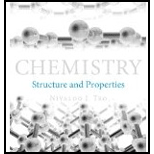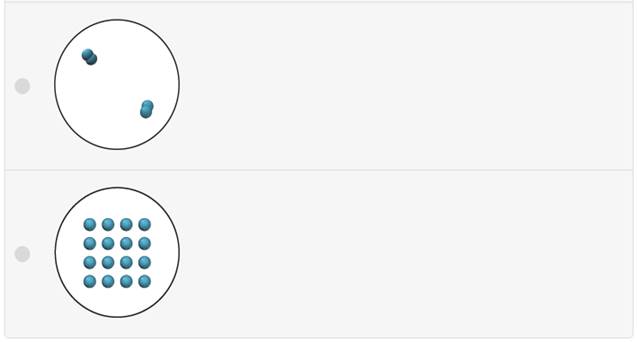
Chemistry: Structure and Properties
1st Edition
ISBN: 9780321834683
Author: Nivaldo J. Tro
Publisher: PEARSON
expand_more
expand_more
format_list_bulleted
Concept explainers
Textbook Question
Chapter 12, Problem 2SAQ
Liquid nitrogen boils at 77 K. This image depicts a sample of liquid nitrogen.

Which image best depicts the nitrogen when it has boiled?

Expert Solution & Answer
Want to see the full answer?
Check out a sample textbook solution
Chapter 12 Solutions
Chemistry: Structure and Properties
Ch. 12 - Prob. 1SAQCh. 12 - Liquid nitrogen boils at 77 K. This image depicts...Ch. 12 - Taking intermolecular forces into account, which...Ch. 12 - What substance experiences dipole-dipole forces?...Ch. 12 - Prob. 5SAQCh. 12 - Prob. 6SAQCh. 12 - Determine the amount of heat (in kJ) required to...Ch. 12 - Prob. 8SAQCh. 12 - Prob. 9SAQCh. 12 - Prob. 10SAQ
Ch. 12 - Prob. 11SAQCh. 12 - Why do ethanol and dimethyl ether have such...Ch. 12 - Why are intermolecular forces important?Ch. 12 - Prob. 3ECh. 12 - Prob. 4ECh. 12 - Prob. 5ECh. 12 - Which factors cause transitions between the solid...Ch. 12 - Describe the relationship between the state of a...Ch. 12 - Prob. 8ECh. 12 - Prob. 9ECh. 12 - Prob. 10ECh. 12 - Prob. 11ECh. 12 - Prob. 12ECh. 12 - Prob. 13ECh. 12 - What is the ion-dipole force? Why is it important?Ch. 12 - Prob. 15ECh. 12 - Prob. 16ECh. 12 - What is capillary action? How does it depend on...Ch. 12 - Explain what happens during the processes of...Ch. 12 - Why is vaporization endothermic? Why is...Ch. 12 - Prob. 20ECh. 12 - What is the heat of vaporization for a liquid, and...Ch. 12 - Explain the process of dynamic equilibrium. How is...Ch. 12 - What happens to a system in dynamic equilibrium...Ch. 12 - Prob. 24ECh. 12 - Prob. 25ECh. 12 - Prob. 26ECh. 12 - Prob. 27ECh. 12 - Prob. 28ECh. 12 - Prob. 29ECh. 12 - Prob. 30ECh. 12 - Prob. 31ECh. 12 - Examine the heating curve for water in section...Ch. 12 - What is a phase diagram? What is the significance...Ch. 12 - Draw a generic phase diagram and label its...Ch. 12 - Prob. 35ECh. 12 - Determine the kinds of intermolecular forces that...Ch. 12 - Determine the kinds of intermolecular forces that...Ch. 12 - Prob. 38ECh. 12 - Arrange these compounds in order of increasing...Ch. 12 - Prob. 40ECh. 12 - Pick the compound with the highest boiling point...Ch. 12 - Pick the compound with the highest boiling point...Ch. 12 - Prob. 43ECh. 12 - Prob. 44ECh. 12 - Prob. 45ECh. 12 - Prob. 46ECh. 12 - Prob. 47ECh. 12 - Water (a) “wets” some surfaces and beads up on...Ch. 12 - The structures of two isomers of heptanes are...Ch. 12 - Prob. 50ECh. 12 - Water in a glass tube that contains grease or oil...Ch. 12 - When a thin glass tube is put into water, the...Ch. 12 - Which evaporates more quickly: 55 mL of water in a...Ch. 12 - Prob. 54ECh. 12 - Spilling room temperature water over your skin on...Ch. 12 - Prob. 56ECh. 12 - The human body obtains 915 kJ of energy from a...Ch. 12 - Prob. 58ECh. 12 - Suppose that 0.95 g of water condenses on a 75.0 g...Ch. 12 - Prob. 60ECh. 12 - Prob. 61ECh. 12 - Prob. 62ECh. 12 - Prob. 63ECh. 12 - Prob. 64ECh. 12 - How much energy is released when 65.8 g of water...Ch. 12 - Prob. 66ECh. 12 - An 8.5 g ice cube is placed into 255 g of water....Ch. 12 - Prob. 68ECh. 12 - Prob. 69ECh. 12 - Prob. 70ECh. 12 - Prob. 71ECh. 12 - Prob. 72ECh. 12 - Prob. 73ECh. 12 - Prob. 74ECh. 12 - Prob. 75ECh. 12 - The high-pressure phase diagram of ice is shown...Ch. 12 - Prob. 77ECh. 12 - Prob. 78ECh. 12 - Prob. 79ECh. 12 - How is the density of solid water compared to that...Ch. 12 - Prob. 81ECh. 12 - Prob. 82ECh. 12 - Prob. 83ECh. 12 - Prob. 84ECh. 12 - Four ice cubes at exactly 00C with a total mass of...Ch. 12 - Prob. 86ECh. 12 - Draw a heating curve (such as the one in Figure...Ch. 12 - Draw a heating curve (such as the one in Figure...Ch. 12 - Prob. 89ECh. 12 - A sealed flask contains 0.55 g of water at 280C....Ch. 12 - Prob. 91ECh. 12 - Prob. 92ECh. 12 - Prob. 93ECh. 12 - Given that the heat of fusion of water is —6.02...Ch. 12 - The heat of combustion of CH4 is 890.4 kJ/mol, and...Ch. 12 - Prob. 96ECh. 12 - Prob. 97E
Knowledge Booster
Learn more about
Need a deep-dive on the concept behind this application? Look no further. Learn more about this topic, chemistry and related others by exploring similar questions and additional content below.Similar questions
- A representation of liquid water is shown below. Which of the three representations that follow best describes the water after it has boiled into steam?arrow_forward8.51 Suppose that three unknown pure substances are liquids at room temperature. You determine that the boiling point of substance A is 53°C, that of substance B is 117°C, and that of substance C is 77°C. Based on this information, rank the three substances in order of their vapor pressures at room temperature.arrow_forwardCooking oil floats on top of water. From this observation, what conclusions can you draw regarding the polarity or hydrogen-bonding ability of molecules found in cooking oil?arrow_forward
- In terms of their bulk properties, how do liquids and solids differ? How are they similar?arrow_forwardSubstance A is composed of molecules that have stronger intermolecular forces than the molecules that compose substance B. Which substance has a lower boiling point? a. substance A b. substance B c. cannot be determined without more information.arrow_forwardIdentify two common observations indicating some liquids have sufficient vapor pressures to noticeably evaporate?arrow_forward
arrow_back_ios
arrow_forward_ios
Recommended textbooks for you
 Introductory Chemistry: A FoundationChemistryISBN:9781337399425Author:Steven S. Zumdahl, Donald J. DeCostePublisher:Cengage Learning
Introductory Chemistry: A FoundationChemistryISBN:9781337399425Author:Steven S. Zumdahl, Donald J. DeCostePublisher:Cengage Learning Chemistry & Chemical ReactivityChemistryISBN:9781133949640Author:John C. Kotz, Paul M. Treichel, John Townsend, David TreichelPublisher:Cengage Learning
Chemistry & Chemical ReactivityChemistryISBN:9781133949640Author:John C. Kotz, Paul M. Treichel, John Townsend, David TreichelPublisher:Cengage Learning
 Chemistry: An Atoms First ApproachChemistryISBN:9781305079243Author:Steven S. Zumdahl, Susan A. ZumdahlPublisher:Cengage Learning
Chemistry: An Atoms First ApproachChemistryISBN:9781305079243Author:Steven S. Zumdahl, Susan A. ZumdahlPublisher:Cengage Learning ChemistryChemistryISBN:9781305957404Author:Steven S. Zumdahl, Susan A. Zumdahl, Donald J. DeCostePublisher:Cengage Learning
ChemistryChemistryISBN:9781305957404Author:Steven S. Zumdahl, Susan A. Zumdahl, Donald J. DeCostePublisher:Cengage Learning

Introductory Chemistry: A Foundation
Chemistry
ISBN:9781337399425
Author:Steven S. Zumdahl, Donald J. DeCoste
Publisher:Cengage Learning

Chemistry & Chemical Reactivity
Chemistry
ISBN:9781133949640
Author:John C. Kotz, Paul M. Treichel, John Townsend, David Treichel
Publisher:Cengage Learning


Chemistry: An Atoms First Approach
Chemistry
ISBN:9781305079243
Author:Steven S. Zumdahl, Susan A. Zumdahl
Publisher:Cengage Learning

Chemistry
Chemistry
ISBN:9781305957404
Author:Steven S. Zumdahl, Susan A. Zumdahl, Donald J. DeCoste
Publisher:Cengage Learning

Types of Matter: Elements, Compounds and Mixtures; Author: Professor Dave Explains;https://www.youtube.com/watch?v=dggHWvFJ8Xs;License: Standard YouTube License, CC-BY